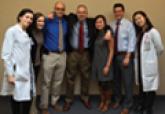For Residents

Giving a Good Needle: Resident Guide to Decreasing Injection Pain
Residency is a time when we set a foundation for how we will practice dermatology in the future. Perfecting good injection technique early in one’...
Roman Bronfenbrener, MD
From the Department of Dermatology, State University of New York, Stony Brook.
The author reports no conflict of interest.
Correspondence: Roman Bronfenbrener, MD, 181 N Belle Mead Rd, Ste 5, East Setauket, NY 11733 (roman.bronfenbrener@stonybrookmedicine.edu).

BRONFENBRENER: What first inspired you to go into dermatology?
BOLOGNIA: I was a third-year medical student and had just finished a rotation in the neonatal intensive care unit, which was particularly demanding; I think you had more clinical responsibilities back then. I was sitting at dinner with some classmates looking for an elective to do, and they all pushed me towards dermatology. It was just what I needed, they said; you only really worked 4 days a week, and the hours were so civilized! My first Friday on the rotation I borrowed Irwin Braverman’s book Skin Signs of Systemic Disease from the clinic and read a good portion of it over the weekend. It struck a chord with me because of its multiple links to internal medicine. The next week I was in dermatology Grand Rounds, and back then the medical students were the first to present their differential diagnoses, prior to and without talking with the residents. It was a bit of sport to hear the rather imaginative diagnoses generated by the students. So when called upon, I stated that I thought my patient had histiocytosis X, and less likely dermatitis. The attending running Grand Rounds questioned me: What could possibly make me think that it was this rare entity histiocytosis X? I told him it looked just like the picture in Dr. Braverman’s book! Everyone got a chuckle out of my answer, but believe it or not, the patient actually had histiocytosis X. Nowadays I would never put histiocytosis above more common entities, but talk about beginner’s luck. I was hooked! The fact that I got the diagnosis right reflects how important a well-written book is for trainees, and I’m honored to still see patients in the same pod as Dr. Braverman.
BRONFENBRENER: What pearls would you give graduating residents now?
BOLOGNIA: I think you have to reflect on what you like to do, what resonates with you, whether you like to take care of people with contact dermatitis, or you like cutting cancer off patients’ faces, or you want to practice phototherapy. Think about where your heart is and that’s what you should do, not what your professors, or your parents, or your chairman thinks you should do. You’re going to be engaged in these activities for at least 30 years, so find something you are passionate about and build on that. Analyze your talents as well as your strengths and go with it. Another important point is to find an area—or 2, or even 3—where you do a lot of reading and then let others know of your interests. Before long you will be able to build upon your greater knowledge and clinical experience and become an expert within a few years. It doesn’t matter if you’re in an academic or private practice; there will always be a niche that you can fill and patients you can help because of your expertise.
BRONFENBRENER: What areas do you find particularly fascinating in dermatology?
BOLOGNIA: Oh, there’s so much! Patients with monoclonal gammopathies, where they can have follicular spines composed of the monoclonal protein coming out of their nose, are fascinating. That’s the kind of dermatology I like: the “believe-it-or-not” side of dermatology. Once I met a patient at a dermatology conference who had fallen down on a farm and had sustained a traumatic brain injury, after which he could only sweat on one side of his body. He had Grover disease limited to the side of his body that could sweat, while the other side was totally clear. We know Grover disease comes from a combination of sweating and sun damage, but seeing that sharp cutoff on his midline drove the point home for me.
BRONFENBRENER: How do you learn best?
BOLOGNIA: I put notes in the margins. If I go to a lecture, I use address labels for my notes. Then I take those stickers and put them in the relevant part of the textbook. It is so much easier to peel off the stickers than it is to write the information. As a result, there is a greater likelihood that the information will actually be transferred.
BRONFENBRENER: What is your daily routine?
BOLOGNIA: Monday, Tuesday, Friday I see patients. Wednesday is Grand Rounds and electronic medical record cleanup time, the paperwork that is no longer on paper. Thursday is my academic day where I can work on projects, and I like this full-day approach because I work best in larger blocks of time. That’s why I recommend, for residents especially, to get a large chunk of their reading done on Saturday or Sunday morning in 2- to 3-hour blocks. I’m not someone who rises hours before everyone else; I’m a 6:00 am type of gal. If you wake up and get your work done during a planned block of time, then you feel like you’ve accomplished something and can enjoy the rest of your day. For me, I’m freshest in the morning, no question about it.

Residency is a time when we set a foundation for how we will practice dermatology in the future. Perfecting good injection technique early in one’...

Diabetes mellitus is a morbid and costly condition that carries a high burden of disease for patients and society as a whole. In dermatology, a...

As residents, we all owe at least some of our knowledge base to the teachings of Dirk M. Elston, MD. I recently sat down with Dr. Elston to find...
